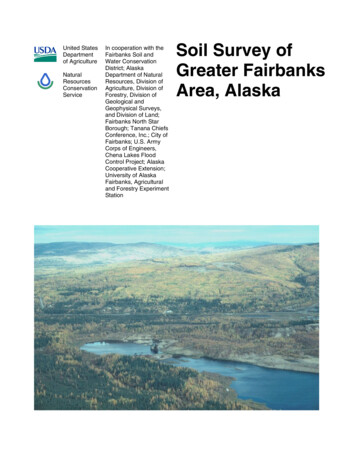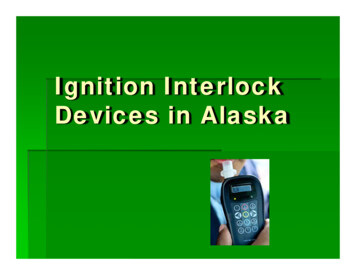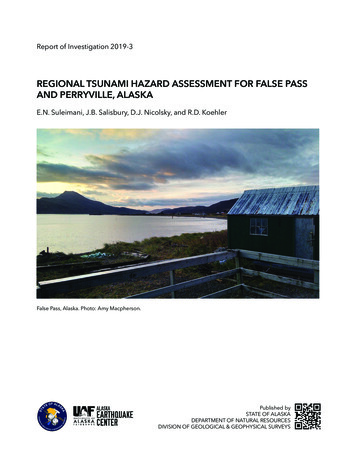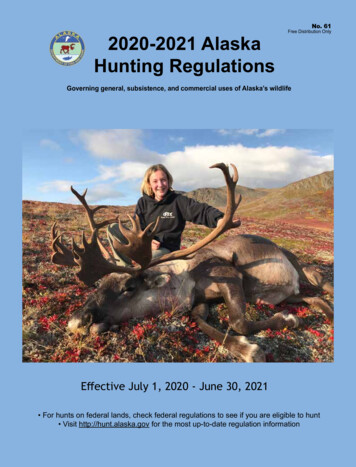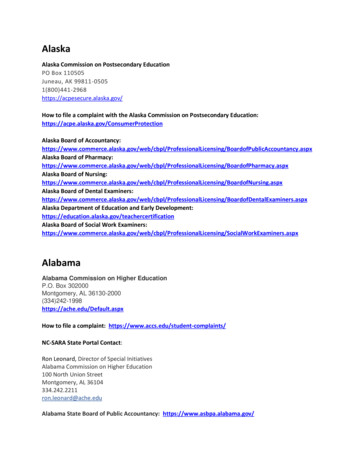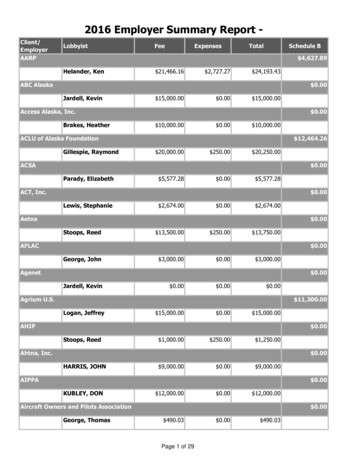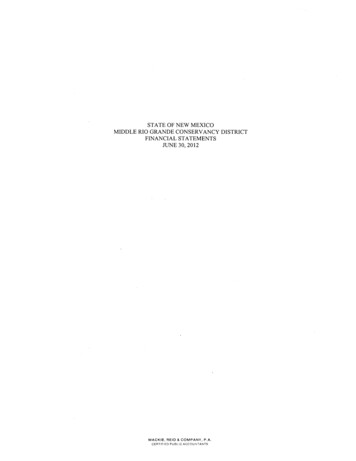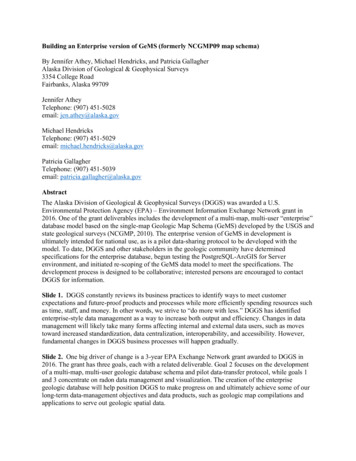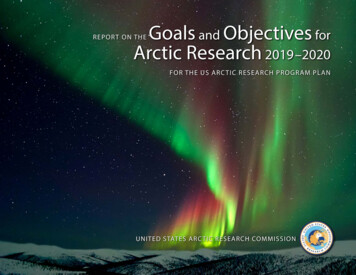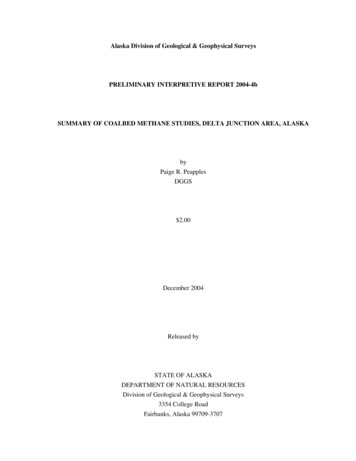
Transcription
Alaska Division of Geological & Geophysical SurveysPRELIMINARY INTERPRETIVE REPORT 2004-4bSUMMARY OF COALBED METHANE STUDIES, DELTA JUNCTION AREA, ALASKAbyPaige R. PeapplesDGGS 2.00December 2004Released bySTATE OF ALASKADEPARTMENT OF NATURAL RESOURCESDivision of Geological & Geophysical Surveys3354 College RoadFairbanks, Alaska 99709-3707
INTRODUCTIONAlaska’s newly-formed shallow gas leasing program allows small independent companies to explorefor unconventional gas resources in Alaska. Although interest is currently limited to a handful ofplayers, the Alaska Division of Oil and Gas (ADOG) is streamlining the shallow gas exploration andleasing process which should lead to additional exploration licenses. The Alaska Division ofGeological & Geophysical Surveys (DGGS) is working with ADOG and the U.S. Geological Surveyon shallow gas producibility studies for rural energy resources.As part of this program, DGGS and Evergreen Resources Alaska, Inc. (Evergreen, recently acquiredby Pioneer Resources) entered into a research partnership in 2002 to investigate the shallow gaspotential of the eastern Nenana Basin in the Delta River area south of Delta Junction, Alaska, whereseveral known coal fields exist (fig.1). Evergreen had at the time acquired more than 300,000 acresof shallow gas exploration leases from the State of Alaska near Delta Junction and Fort Greely ArmyPost. DGGS responsibilities were to:?prepare a comprehensive bibliography of coal-related geologic information for thearea,?compile existing geologic map data using a geographic information system (GIS),?research and evaluate available basin hydrogeologic data,?reconstruct the tectonic history of the basin, interpret regional and local stresses,?identify fracture networks,?evaluate the fluid flow regime,?collect structural data and model gas pathways,?sample and analyze coal, and?prepare a volumetric analysis of coal and gas resources.Evergreen planned exploratory drilling, an airborne geophysical survey at Jarvis Creek, and providedhelicopter support and personnel to participate in geologic field investigations. LANDSAT imagerywas processed and provided by an Evergreen contractor.Many of the planned activities were completed. However, due to weather limitations, the statisticallyviable dataset required to complete volumentric analyses was not collected. In July 2003, Evergreenelected not to renew the Delta Junction area leases based on seismic results that confirmed surfacegravels (Nenana Gravel) in excess of 1,000 feet within the leased area. Such thicknesses precludedexploratory drilling and further study. Although the project came to an end for these reasons, DGGSinterest in the Jarvis Creek area continues in association with other rural energy and Interior basinresearch programs.BACKGROUNDThe Delta/Jarvis Creek area was selected for study primarily because the Tertiary coal-bearing sectionhere may have economic importance as a shallow gas source. DGGS has undertaken several basinanalysis and exploration projects as part of the Interior Basins and Coalbed Methane for Rural AlaskaEnergy programs. As the Alaskan energy industry diversifies and expands into the natural gas realm,DGGS had planned to support industry constituents by investigating gas resources in this potentiallyviable area.An abandoned open-pit coal mine is located three miles east of the Richardson Highway along OberCreek within the Jarvis Creek Coalfield. Delta Coal Company operated the mine during the 1960sbut production was limited to local use (Belowich, 1988). Detailed geologic mapping does not existand any coalbed gas prospects here remain unknown. Baseline data would provide impetus forprivate industry to pursue shallow gas leases in the area. City planning at Delta Junction, a secondPIR 2004-4bPage 1
class city just 20 miles north of the area, could directly benefit from a nearby alternative fuelresource. Because the coalfield is located near existing infrastructure, its significance as a producibleshallow gas source would be increased should gas reserves be identified. The development of suchlocal gas sources would benefit small Alaskan communities by creating jobs and by decreasing oreliminating the environmental hazards associated with imported diesel fuel.The area is also of great interest from a neotectonic perspective. The November 2002, M7.9 Denalifault earthquake disrupted the Trans-Alaska oil pipeline less than 50 miles to the south. Significantground rupture, surface offsets, and landslides occurred along the Denali fault near the oil pipeline.Studies of active faults and the structural setting are now underway to assess the potential damage afuture earthquake here could pose to communities, infrastructure, and the pipeline. Identification ofstructures in the area, especially those suspected of recent activity, could aid these hazard evaluations.Surficial studies associated with the coal investigation would have allowed identification ofunconsolidated materials that have been affected by recent seismic activity.Figure 1. Generalized location map of the Delta Junction area.LOCATION AND GEOLOGIC SETTINGThe Delta River is a very large braided river of glacial outwash south and west of the RichardsonHighway in the northern foothills of the Alaska Range, twenty miles south of Delta Junction innorthcentral Alaska. Jarvis Creek is a braided tributary of the Delta River to the east on the southernPIR 2004-4bPage 2
border of the Fort Greely Army reservation. It flows northward 35 miles from its glacial source in theeast-central Alaska Range before joining the river near the city of Delta Junction, about 100 milessoutheast of Fairbanks. The Jarvis Creek coalfield is located west of Jarvis Creek. Coal Mine Road,east of the highway, provides access to the abandoned Ober Creek coal mine and the eastern portionof the study area.Peaks at the southern boundary of the study area reach elevations of 6,000 feet and incised creeks exitthe mountains via steep gorges. The majority of the area includes rolling hills that range in elevationfrom about 1,700 feet at the Delta River to about 3,000 feet. Donnelly Dome and Granite Mountainare two prominent highs at the northern boundary of the study area and stand at 3,900 feet and 4,995feet, respectively.This part of Alaska is composed of many distinct terranes of both oceanic and North Americanaffinity. These tectonostratigraphic packages were accreted onto southern proto-Alaska duringnortheastward motion and oblique subduction of the Pacific plate. The terranes are bounded by majorthrust faults along many of which right-lateral strike-slip displacement has occurred. The YukonTanana Terrane is interpreted as a Devonian igneous arc intruded by Devonian gneiss and lateCretaceous plutons, and is multiply metamorphosed and deformed. The Tertiary coal-bearing sectionat Jarvis Creek lies unconformably on this crystalline basement (fig. 2). Although not extensive, thissection suggests potential as an economic deposit mainly due to its convenient location, and mayprovide an analog to coal deposits in the subsurface.PIR 2004-4bPage 3
Figure 2. Schematic map illustrating the regional geologic setting of the Jarvis Creek coalfield area.Glaciated areas are shown in white. Geology from Wilson et al. (1998).Seismic activity in this region is common; the most recent large event was the M7.9 event ofNovember 2002. Most of the motion occurred along the Denali fault, which is an important structuralfeature in Alaska and accommodates large amounts of right-lateral slip. The Donnelly Dome-GraniteMountain fault is also an important feature in this area, and a topic of current study, as surficialdeposits are differentially offset along its length. Slip direction and fault dip also appear to bePIR 2004-4bPage 4
variable. Both of these structures lie near the Trans-Alaska oil pipeline and the Richardson Highwaynear the Jarvis Creek area.Coal deposits in the Nenana Basin, situated north of the Alaska Range, are late Oligocene throughMiocene in age (Belowich, 1988). The largest known occurrence is the commercial deposit of theUsibelli Coal Mine at Healy, Alaska, at the western end of the basin. Here the Suntrana Formation,of the Nenana coal-bearing group (informal), is the main producing formation (fig. 3). Otherexposures along the basin trend are limited in outcrop and are far from infrastructure, makingexploration logistically difficult and expensive. Most are exposed in structural lows where bedrocktopography allowed both deposition and preservation of sediments. These accumulations aregenerally lenticular and laterally discontinuous.Figure 3. Generalized sections at Healy Creek, at the western end of the Nenana Basin, and at JarvisCreek.At Jarvis Creek the coalfield includes an incomplete section of the Nenana coal-bearing group, and isabout 2,000 feet thick. It has been divided into three lithologically distinct horizons by Wahrhaftig(1955). The lower (quartz sand and conglomerate) and middle (arkosic sand) horizons are identifiedas the Healy Creek formation. The upper horizon (lithic sand) has been identified as the LigniteCreek formation (Belowich, 1988). The other members of the group, including the Suntrana,Sanctuary, and Grubstake Formations, are not found at Jarvis Creek.Wahrhaftig, Moffit, and Belowich all describe possible tectonic scenarios for deposition of the coal.Initial late Oligocene deformation and uplift to the south was followed by local uplift to the north inearly Miocene. Thus both schistose and granitic sources are indicated for the quartzose, arkosic, andlithic coal-bearing sands (Belowich, 1988).PIR 2004-4bPage 5
The coal-bearing sediments dip slightly to the north. Coal seam thickness varies from a few inchesup to about 40 feet. Coal grade is primarily sub-bituminous, and anomalously high sulfur contentsare common (Belowich, 1988; Stull and Peapples, 2003). Cleats, or fractures within coal, controlpermeability of the coal and gas production. Well developed, densely spaced cleats allow gasmigration with less necessity for artificial fracturing. At Jarvis Creek, coal cleating is variable withinand between seams.The Nenana Gravel overlies the coal-bearing units throughout the Nenana Basin and representsdeposition during renewed late Cenozoic uplift of the Alaska Range to the south (Capps, 1912;Wahrhaftig et al., 1951; Csejtey et al., 1992). This 4,000-foot thick package of poorly consolidatedconglomerate blankets most of the Delta River area and is a major influence on the economic viabilityof any coalbed methane reservoirs at depth.Quaternary deposits in the Delta River area record at least four periods of glaciation (Péwé and Reger,1983; Péwé and Holmes, 1964). Moraines, eolian loess deposits, and glacial outwash plain depositsare common along with discontinuous permafrost and buried ice wedges. The western portion of theproposed map area is characterized by knob and kettle moraine topography and scattered permafrostmelt ponds.PREVIOUS WORKExisting geologic mapping includes 1:63,360-scale USGS mapping of coal-bearing units in the area(Wahrhaftig and Hickcox, 1955). Nokleberg et al. (1992) produced a 1:250,000-scale map of theMount Hayes Quadrangle. A 1:50,000-scale compilation by Péwé (1960) for the United States Armyincluded generalized bedrock geology after Wahrhaftig and additional air photo interpretation ofsurficial units. A USGS compilation (Weber, 1971) was prepared to aid corridor selection for theTrans-Alaska Pipeline System (TAPS). Mike Belowich completed a Master’s Degree sedimentologicthesis study of the coal-bearing units in 1988, including petrographic and geochemical studies.RESULTSDGGS completed a comprehensive bibliography for Delta area coal resources (this report). A GIScompilation included point data, basemap data, available remote-sensing data, and geologicalcoverages (DGGS and USGS). This data set was utilized in-house to help identify potential fieldinvestigation locations, to more comprehensively analyze existing information, and to interpret newfindings.Available hydrologic information included primarily well log data for a few private and commercialwells drilled in the region. We also researched published and unpublished geophysical data.Analysis of these data was subjective as few wells penetrated bedrock and none encountered coalseams. Interpretation of all available data sets indicated thick ( 1,000 feet) gravel cover existedacross most of the study area. Because the exploratory drill holes were not drilled, the extensivestructural data necessary for coal or gas volumetric analyses and for fluid and gas migration analyseswere not available.During September 2002, a limited helicopter-supported sampling effort was conducted by DGGS andEvergreen personnel to characterize coal seams in Nenana Basin deposits near the leased acreagewest of the Delta River. DGGS and Evergreen personnel also visited the Jarvis Creek area to samplecoals and sands from the coal-bearing deposits and to collect reconnaissance structural data andmagnetic susceptibility measurements. 2002 and 2003 data can be found in Belowich (2004).Coal samples from the Tertiary rocks were collected for Proximate and Ultimate analyses tocharacterize their potential as a shallow gas source. To aid understanding of the coal-bearing sectionas a gas reservoir and producer, structural data were collected including cleat and fracture orientation,PIR 2004-4bPage 6
aperture, and frequency. Thin sections were prepared and used as an aid to differentiate the basinsands and to interpret their porosity and permeability. Results for 2002 samples from the NenanaBasin and Jarvis Creek are listed in Stull and Peapples (2003) and are described in Belowich (2004).Thin section analysis of 2002 sediment samples from Jarvis Creek indicated both lithic fragments andquartz dominate the sand units. Visual inspection showed tight packing of grains and low tomoderate porosity and permeability. Because many outcrops were poorly consolidated, some 2002reconnaissance samples provided only cursory interpretation of reservoir quality. Because no apatitewas identified in the 2002 suite of thin sections from the Jarvis Creek coalfield sands, no fission-trackstudies were completed.The 2003 structural data collection effort was limited due to weather but included bedding, cleat, andfracture orientation measurements. Bedding orientations were difficult to measure in many of thepoorly consolidated Tertiary sands. Coal face cleat measurements showed generally northeasttrending strikes generally parallel to bedrock schistosity measurements at Jarvis Creek. Cursoryinspection of LANDSAT imagery shows lineations suggestive of faulting in a northwest-strikingtrend generally parallel to the Alaska Range front and to bedding trends of sediments flanking themountains to the south. Additional structural data for fracture and fault networks and fission-trackdata (from Granite Mountain, for example) would be useful toward a meaningful tectonic history ofthe region. Sean Bemis (2004) has offered a preliminary tectonic analysis of the Healy range frontarea that may have regional implications for the eastern Tanana Basin.Magnetic susceptibility data were collected during 2002 to aid in interpretation of airbornegeophysics. Coal and graphitic schist bedrock values ranged from .01 to .05 (SI units), while sandranged from .06 to .25. Evergreen plans for an airborne geophysical survey were subsequentlyreplaced by a high resolution seismic survey. This survey, conducted in spring 2003, confirmed thepresence of thick surficial gravel deposits. These data are available for purchase directly fromEvergreen.CONCLUSIONSIt is evident from outcrop reconnaisance that conditions for Tertiary coal formation were favorable,although distribution patterns (localized or continuous) are more ambiguous. Structural activityduring deposition could have localized accumulations or disturbed and reworked carbonaceousmaterial. Subsequent uplift and deposition have deeply buried a presumably great extent ofremaining coal horizons.While industry interest in the Delta and Jarvis Creek area has waned, the need for local energyresources persists. Significant funds would be necessary to drill through the thick surficial gravelsand investigate the subsurface extent of coal-bearing horizons and to analyze their gas reservoirpotential.ACKNOWLEDGMENTSFunding for this project was provided by collaborators Evergreen Resources Alaska, Inc. (nowPioneer Resources Alaska) and DGGS. Field work was conducted by Mike Belowich, PaigePeapples, and Rocky Reifenstuhl. The manuscript was reviewed by Jim Clough and Rod Combellickof DGGS.PIR 2004-4bPage 7
COMPREHENSIVE BIBLIOGRAPHYBelowich, M.A., 1988, Stratigraphy, petrology, and depositional environments of the Jarvis Creekcoalfield, East-Central Alaska: Master of Science thesis, University of Alaska Fairbanks, 135p., 2 sheets.Belowich, Michael, 2004, Delta Junction coalbed methane exploration project, geologic summary,Alaska Division of Geological & Geophysical Surveys Preliminary Interpretive Report 20044a, 21 p.Bemis, S.P., 2004, Neotectonic framework of the north-central Alaska Range foothills: Master ofScience thesis, University of Alaska Fairbanks, 152 p.Brunett, J.O., 1986, Ground-water levels in Alaska, water year 1983: U.S. Geological Survey OpenFile Report 86-56, 229 p.Capps, S.R., 1912, The Bonnifield region, Alaska, U.S. Geological Survey Bulletin 501, p. 30.Clough, James G., 1995, Summary of coal resource potential of the Jarvis Creek coal field: AlaskaDivision of Geological & Geophysical Surveys Public Data File 95-22, 23 p.Csejtey, B., Jr., Mullen, M.W., Cox, D.P., and Stricker, G.D., 1992, Geology and geochronology ofthe Healy quadrangle, south-central Alaska, U.S. Geological Survey MiscellaneousInvestigations Map I-1961, 1:250,000.Dusel-Bacon, C., and Murphy, J.M., 2001, Apatite fission-track evidence of widespread Eoceneheating and exhumation in the Yukon-Tanana Upland, interior Alaska: Canadian Journal ofEarth Sciences v. 38, No. 8, pages 1191-1204.Frost, G.M., Barnes, D.F., and Stanley, R.G., 2002, Geologic and isostatic map of the Nenana Basinarea, central Alaska, US Geologic Survey Geologic Investigations Series I-2543, 17 p.Geomatix Consultants, 1997, Site-Specific earthquake ground motion study for radar building site,Clear Air Force Station, Alaska; prepared for US Army, project no. 3993.Joesting, H.R., 1941, The geology and ore deposits of Ptarmigan Creek, Mt. Hayes District: AlaskaTerritorial Department of Mines Prospect Evaluation 68-01.Merritt, R.D., 1985, Field trip guidebook: Lignite Creek and Healy Creek coal fields, Nenana Basin,Alaska: Alaska Division of Geological & Geophysical Surveys Public Data File 85-19, 58 p.Merritt, R.D., 1985, Coal resources, exploration, and development in Alaska: Alaska Division ofGeological & Geophysical Surveys Public Data File 85-20, 22 p.PIR 2004-4bPage 8
Merritt, R.D., 1985, Coal atlas of the Nenana Basin, Alaska: Alaska Division of Geological &Geophysical Surveys Public Data File 85-41, 197 p.Merritt, R.D., 1986, Alaska coal fields and seams: Alaska Division of Geological & GeophysicalSurveys Public Data File 86-67, 41 p.Merritt, R.D., 1986, Geology and coal resources of the Wood River Field, Nenana Basin: AlaskaDivision of Geological & Geophysical Surveys Public Data File 86-68, 37 p.Merritt, R.D., 1986, Paleoenvironmental and tectonic controls in the major coal basins of Alaska:Alaska Division of Geological & Geophysical Surveys Public Data File 86-73, 74 p.Merritt, R.D., 1986, Alaska: coal fields and seams 1987: Alaska Division of Geological &Geophysical Surveys Public Data File 86-90, 55 p.Merritt, R.D., Hawley, C.C., 1986, Map of Alaska's coal resources, scale 1:2,500,000. AlaskaDivision of Geological & Geophysical Surveys Special Report 37, 1 sheet, scale 1:2,500,000.Merritt, R.D., 1987, Evaluation of Alaska's coal potential 1982: Alaska Division of Geological &Geophysical Surveys Public Data File 86-92, 18 p.Merritt, R.D., 1988, Alaska bituminous coal and anthracite: Alaska Division of Geological &Geophysical Surveys Public Data File 88-15, 116 p.Metz, P.A., Rao, P.D., and Smith, J., 1981, Mine plan and preliminary feasibility study for the JarvisCreek coal field – a model for small scale mine development: University of AlaskaFairbanks, Mineral Industry Research Laboratory, unpublished report, 70 p.Moffit, F.H., 1942, Geology of the eastern part of the Alaska Range and adjacent area: USGeological Survey Bulletin 989-D, p. 136.Moffit, F.H., 1942, Geology of the Gerstle River district, Alaska: US Geological Survey Bulletin926-B, p. 107.Nokleberg, W.J., Aleinikoff, J.H., Lange, I.M., Silva, S.R., Miyaoka, R.T., Schwab, C.E., and Zehner,R.E., 1992, Preliminary geologic map of the Mount Hayes Quadrangle, eastern AlaskaRange, Alaska, U.S. Geological Survey Open-File Report 92-594, 39 p., 1 sheet, scale1:250,000.Nokleberg, W.J., Foster, H.L., and Aleinikoff, J.N., Geology of the northern Copper River basin,Eastern Alaska Range, and southern Yukon-Tanana upland, in Schmidt, R.A.M., Nokleberg,PIR 2004-4bPage 9
W.J., and Page, R.A., eds., 1989, Alaskan Geological & Geophysical Transect, Valdez toColdfoot, Alaska, American Geophysical Union Field Trip Guidebook T104, 131 p.Péwé, T.L., 1960, Geology of the Mount Hayes D-4 Quadrangle, Alaska, US Army EngineerIntelligence Study 264, plate 2-B, scale 1:50,000.Péwé, T.L., and Holmes, G.W., 1964, Geology of the Mount Hayes D-4 Quadrangle, Alaska, U.S.Geological Survey Miscellaneous Geologic Investigations Map I-394, scale 1:63,360.Péwé, T.L., and Reger, R.D., 1983, Delta River area, Alaska Range, in Péwé, T.L., and Reger, R.D.,eds. Guidebook to permafrost and Quaternary geology along the Richardson and GlennHighways between Fairbanks and Anchorage, Alaska, Fourth International Conference onPermafrost, July 1983, Guidebook 1, Alaska Division of Geological & Geophysical Surveys,p. 47-135.Rao, P.D., 1986, Characterization and evaluation of washability of Alaskan coals: Fifty selectedseams from various coal fields: Final technical report, Sept. 30, 1976 – Feb. 28, 1986:University of Alaska Fairbanks, Mineral Industry Research Laboratory Report 75, 184 p.Reger, R.D., and Péwé, T.L., 2002, Geologic Map of the Big Delta A-4 Quadrangle, Alaska: AlaskaDivision of Geological & Geophysical Surveys Report of Investigations 2002-2.Rose, A.W., 1965, Geology and mineral deposits of the Rainy Creek area, Mt. Hayes Quadrangle,Alaska: Alaska Division of Geological & Geophysical Surveys Geophysical Report 14, 57 p.Schmidt, R.A.M., Nokleberg, W.J., and Page, R.A., eds., 1989, Alaskan Geological and GeophysicalTransect, Valdez to Coldfoot, Alaska, American Geophysical Union Field Trip GuidebookT104, 131 pp.Stull, R. and Peapples, P., 2003, Coal analyses (proximate and ultimate) from the Delta Junction area,Alaska: Alaska Division of Geological & Geophysical Surveys Raw Data File 2003-1, 12 p.Thomas, B., 1943, Donnely coal field (“Big Delta” coal field): Alaska (Terr.) Department of Mines,unpublished report, 4 p.Wahrhaftig, C., Hickcox, C.A., and Freedman, J., 1951, Coal deposits on Healy and Lignite Creeks,Nenana coal field, Alaska, with a section on clay deposits on Healy Creek by E.H. Cobb, inBarnes, F.F., ed., Coal investigations in south-central Alaska, 1944-1946, U.S. GeologicalSurvey Bulletin 963-E, p. 141-165.Wahrhaftig, C., and Hickcox, C.A., 1955, Geology and coal deposits, Jarvis Creek coal field, Alaska:USGS Bulletin 989-G, 353 p., 3 plates.PIR 2004-4bPage 10
Wahrhaftig, C., Wolfe, J.A., Leopold, E.B., and Lanphere, M.A., 1969, The coal-bearing group in theNenana Coal Field, Alaska, U.S. Geological Survey Bulletin 1274–D, 30 p.Warfield, R.S., 1973, Rotary drilling for strippable coal in the Jarvis Creek coalfield, Alaska, USBureau of Mines Open-File Report 7-73, 35 p.Weber, F.R., 1971, Preliminary engineering geologic maps of the proposed Trans-Alaska pipelineroute, Mount Hayes Quadrangle, US Geological Survey Open-File Report 71-0318, 2 sheets,scale 1:125,000.Wilcox, D.E., 1980, Geohydrology of the Delta-Clearwater area, Alaska: USGS Water ResourcesInvestigation 80-92, 26 p.Wilson, F.H., Dover, J.H., Bradley, D.C., Weber, F.R., Bundtzen, T.K., and Haeussler, P.J., 1998,Geologic Map of Central (Interior) Alaska: USGS Open-file report 98-133, 63 p., 3 plates.PIR 2004-4bPage 11
SUMMARY OF COALBED METHANE STUDIES, DELTA JUNCTION AREA, ALASKA by Paige R. Peapples DGGS 2.00 December 2004 Released by STATE OF ALASKA DEPARTMENT OF NATURAL RESOURCES Division of Geological & Geophysical Surveys 3354 College Road Fairbanks, Alaska 99709-3707 . PIR 2004-4b Page 1

